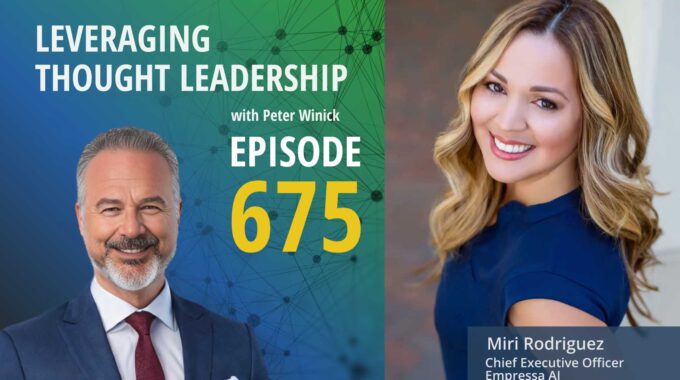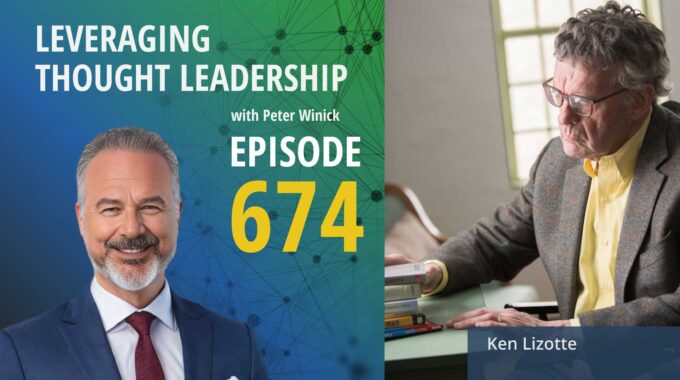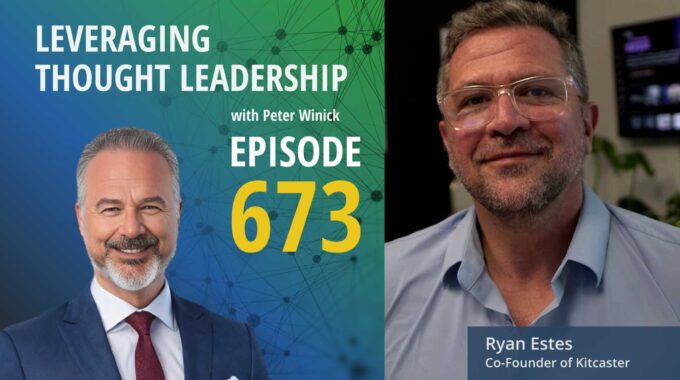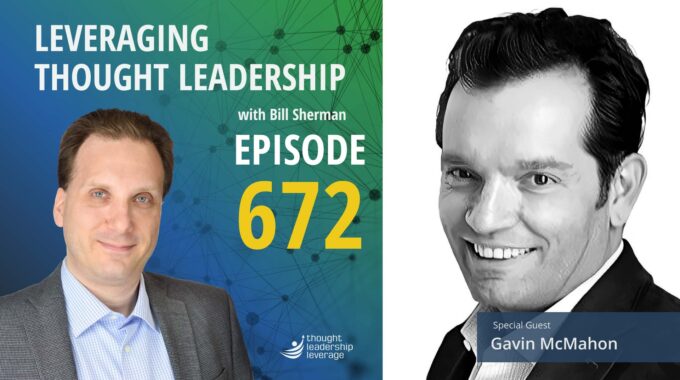Building Brand Love Through Storytelling This episode explores how storytelling can drive inclusion, purpose, and…
The changing role of sales in thought leadership | Mark Hunter
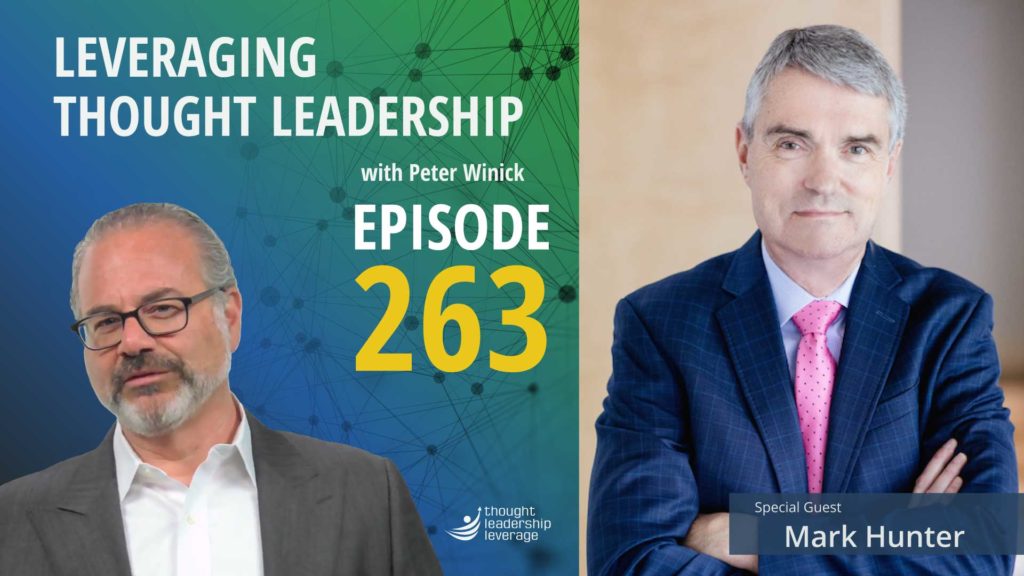
Today’s guest is Mark Hunter, author of best-selling books High Profit Prospecting, High Profit Sales, and his newest book A Mind for Sales. Mark is a Certified Speaking Professional, and one of the top 50 sales and marketing leaders in the world.
Mark shares with us how the role of sales has changed over the years as technology has evolved. He explains how sales is changing again in the face of COVID-19. Furthermore, we discuss how to modify sales training to deliver it online with the same efficiency as in person.
Mark talks about the need to protect your fee, regardless of the method your content is delivered because your fee should be based on the outcome of your content.
This episode is full of amazing sales tips from one of the world’s best! If you want to keep up with the changing landscape, you’ll want to tune in to this episode.
Three Key Takeaways from the Interview:
- Sell your thought leadership is less about education and more about helping a client to see what they did not think was possible.
- If you need to take your sales training online, you’ll need to break your thought leadership into smaller bite-sized chunks then you would for a two-day event.
- The price of your thought leadership needs to be based on the outcomes you deliver and not the method of delivery.
Do you want to increase your thought leadership sales opportunities, grow your exposure to target groups and markets? Increase your platform’s leverage through relationships with individuals and organizations aligned with your vision. Contact Thought Leadership Leverage for assistance.
Transcript
Peter Winick Welcome, welcome, welcome. This is Peter Winick. I’m the founder and CEO at Thought Leadership Leverage. And you’re joining us on our podcast, which is Leveraging Thought Leadership. Today, my guest is Mark Hunter. He goes by the name of the Sales Hunter. He is a CSP. That’s a sort of AI speaking title. Basically, the sales hunter is recognized as one of the top 50 most influential sales and marketing leaders in the world. He is author of three bestselling books, high Profit Prospecting, AI, profit selling and his newest, A Mind for Sales. On its first day of release. That book hit number one on the Amazon list. Mark has spoken in five continents, and he’s travels more than 200 days per year, working with people to show them how to find and retain better prospects. He always sends the best sell he ever made. He was proposing to his wife. 39 years later, Mike and his wife to marry children and four grandchildren. And you can always check out more about Mark at the sales hunter.com. So welcome aboard. Mark. Instead of talking about your moves, we’ll talk to you So.
Mark Hunter Well, I guess we should. I mean, who cares about talking? Yeah let’s just talk. Let’s have a conversation.
Peter Winick Yeah. So here we go. You have been at this craft for quite some time. I won’t say how long, but a while.
Mark Hunter It’s a long time. We’ll leave it at that.
Peter Winick Yes, exactly. And it’s changed it. Then it stayed the same and then it changed. And then it’s changing again. What’s been consistent is, you know, sort of your content and most of the message, although it’s refined, maybe let’s start by telling us a little bit about how did you get here? So this is not like I’m sure when your kids were at the age when they were choosing careers, none said, I’d like to be a sales hunter.
Mark Hunter Well, yeah. I mean, that really is we all go down a journey in life that takes so many different twists and turns. And the key thing is being able to read the tea leaves as you go. Have I miss some tea leaves? Man, I’ve missed some big ones. I’m sure everybody can sit there and say that, but you hope that you turn over enough positive ones that move you in the right direction. But here’s what it comes down to. It’s what’s the outcome that you want to create in others? And that’s what is probably shaped me the most, especially over the last ten years. Focus on the outcomes you create for people, not on not on the process, not on the delivery.
Peter Winick So I love that. I often when I’m working with clients say, okay, so as a result of X, some intervention by you, your content, exposure to your books, whatever, what’s the skill out, what’s the outcome, what’s going to be different? And that different might be tactical, it might be mindset, it might be something else. But give me an example of an outcome that you shoot for with your audiences.
Mark Hunter Well, the outcome that I shoot for is is really my definition of sales and is to help others see and achieve what they didn’t think was possible. So the outcome what I’m trying to do is I’m trying to empower you as a salesperson to be confident and competent enough to where you can take somebody who doesn’t know they need something, but you know, it would work right for them and be able to get them to buy that, use it. And it’s not to buy it, it’s to use it and to benefit from it.
Peter Winick And you don’t get that benefit until you buy it. Right. So the price.
Mark Hunter Right. Yeah. And the benefit is not buying it. The benefit is the outcome you get because you bought it, whatever it might be.
Peter Winick Yeah. Got it. So sales and sales training as a result have changed a lot over the years, right? So it used to be, depending on how far back we go, we’re not going to go back to the door to door salesmen. I think that’s before most of our time. But, you know, the cold calling days, you know, the call center days, the outbound, you know, ring the bell days, then we move to sort of a higher level of consultative selling. Then we move to sort of you know, it used to be the first 30, 40% of interactions that most salespeople beat A, B, or B, the C had with the client was the educational phase. The Internet’s taken that much, not all of that away. So lots of change, lots of things to do to stay on top of your game. How have you evolved both your content and the modalities by which you offer it to the market to keep up with the changes?
Mark Hunter Well, that’s a great I mean, what we could run for an hour, right? Like, you know, if you start to think about this, the role has changed because the Internet takes so much. Like you said, the educational process. But what we have to do now is clarify. Our job is not to educate you. Our job is to ask you questions, to help you see what you didn’t think was there or to help us confuse you. That’s really the role. If you think about Steve Jobs, when Steve Jobs came out with the iPhone, did we know that we needed a music player? Did we know that we needed a camera and a computer and a phone all in the same device? No, we didn’t know that. We did not know that at all. But what did Steve Jobs have to do? He had an unclear if I know all of our preconceived notions to get us to buy into the iPhone. And of course, today, nobody does not have a smartphone.
Peter Winick Exactly. Exactly. Talk a little bit about the modalities. So you spend or have spent much of your time, a vast majority of your time on the road in front of audiences, delivering your message. Right. Then we have this little bit of a Covid thing happening which sort of puts a kingpin in the armory. Know people still need to sell. People need to understand it. People still need to buy. So for the moment, in many places, we can’t be in the same room doing that or even when we are, it’s different. How are you evolving and trying to meet the needs that are out there?
Mark Hunter Yeah, first of all, I have to realize that the outcomes I create don’t change the outcomes. This is what I tell everybody. The just because of Covid, the outcomes don’t change the means with which you deliver them. The means with which you interact has changed. That’s what’s changed tremendously. It’s kind of funny. I look at my schedule now. I don’t know how I had time to travel before. I don’t know what’s happening. Crazy. I mean, I started this morning at 5 a.m. with a coaching call to Switzerland. And now it is 4 p.m. Central Time. And after this, I’ve still got another two-hour event later on this evening. In between, I’ve got to somehow get caught up on email and everything else. What? We’re fine.
Peter Winick And you weren’t in an Uber to the airport, to the delay, to the club to today. Right, right, right, right.
Mark Hunter Because what’s very interesting is when I used to travel and in fact, later on this week, I actually get on an airplane for the first time in about three months, you would be focused in on one client pretty much 80% for that day. You’d be zero in age to be catching up on it. Many of you right now I feel like a pinball. I’m one hour here, one hour there, one hour there. I mean, I have done so many different things with different clients and different projects over the course of the day.
Peter Winick But the back up a little bit because. You know, all of a sudden, you know, what you were selling before is Mark comes to a place. Mark speaks and delivers workshops. And then Mark goes home to the next place. So one is you have to be able to have a conversation with the clients and say, Listen, all of the value I was able to deliver, here’s some new ways that I do that that would be valuable to you and impactful to you. So tell me about some of those conversations.
Mark Hunter Okay.
Peter Winick You had to resell it. But you had to sort of re-calibrate expectations. What I’m going to do, I’m going to do it where I’m going to do it.
Mark Hunter Yes. For instance, there is a client. I was I was on this exact setup, Zoom set up from 830 to 930 this morning for an hour with a sales team out of Atlanta, Georgia. And I’ve done five of these and I’m going to do three more of them. And what am I doing? I am delivering my two day training program. Now over the course of one hour sessions. So, I mean, we could have said, do it all at one time now, but the butt can only endure. So, you know, you can’t get Zoom fatigue. Now, Wednesday of this week, I’m doing a two hour Zoom event for an audience of about 65 salespeople. Okay. And then I’ll back that up with a series of shorter sessions in the weeks following that. So it is so the outcomes are still the same. Again, we just shift how we deliver the means with which with which we deliver.
Peter Winick So let me ask you this. So a lot of folks are struggling and maybe struggling is not the word or they’re being challenged by, listen, I do what I do really well. Get me in front of a room as long as the room is meets my specs of I have, here’s how I like it. Set up round tables and this line, blah, blah, blah, blah. And it doesn’t matter if you’re in Denver, Cleveland or Dubai, right? You walk into the room, bang, you’re in the zone, right? You actually and this is where I want to drill down on because you sort of fast forward to and I think it’s really important say, wait a minute, what I used to do in two days. What are the logical places for me to chunk this? Because nobody wants to be on a two days on call. That’s not going to happen. Right. And I think we’re stretching the boundaries of what is logical there. But so you whether it’s an hour or two hours, you actually have to go through your content and it’s not just hit the pause button like Netflix, but be thoughtful around this model goes great with this one. And actually in between this hour and the time we meet again next week. Let me throw some stuff out. So tell me about sort of the design.
Mark Hunter Well, that’s exactly right, because I got to figure out how is some content I can spoon out to people in between. Is there a short 92nd video or two minute video I can throw out to them? Do I need to have a phone call with this manager or do you have a phone call with that with that particular person? There’s for instance, there’s another group that I meet with every Thursday at 10:00, every third team all over the country. Normally we would do it all gather together, but not dispersed. And again, but like one of the guys emailed me and says, Marc, I’d love to get 30 minutes with you one on one. Okay. Sure. All right. We have to do that. Because think about it, I normally would have done that over break or over, like if if we’d been on site. So. Exactly. Yeah. But what happens is now I’m spending more time managing my calendar and also managing my headset, because what happens is my mind shifts. Now, for instance, I’m deliver I’m speaking to you right now. I’m standing up. I have I have three different studio setups that I can use. This one happens to be standing up because I have more energy today. Most of the programs I’ve been doing, I’ve been doing from here. But I’ve also got another setup where I’m able to sit at a desk and I’ve got another setup that’s in a true office. So again, depending on the mode, depending on what I’m delivering the context. And what else is on the docket for the day? I set myself up accordingly.
Peter Winick So it’s interesting. I was going to ask you earlier and I didn’t about that’s an interesting set up that you’re standing. Right. Actually puts me in the mindset more of, Mark’s sort of in the front of the room. I can see his arms gesticulate, you know, Mark, Mark, like most speakers, you don’t want to stand still. You want to. Right, right, right. You’re sitting at a desk, you’re physically constrained. So what you’ve done is aligned the content to I’m going to deliver this hour standing because that’s me sort of I need to be a little more motivational. This is a little bit more eye level. I need to be sitting at my desk and talking about things. So that’s issue. You just sort of designed the different elements and forth, the infrastructure, the set that you have, these that could also be virtual.
Mark Hunter If you want to. Yeah, but this is so beautiful because like tomorrow morning I have an executive call with four executives from a company. I’m going to be at my desk, I’m going to be at my desk and it’s going to be a very formal just like we’re around the boardroom. I would do I would speak to them standing up like this. That’d be very pretentious. And you’re like, what? What? What is going on? Interesting. So again and again, these are these little shifts that you have to be prepared to do. But what does it do? I think what this does is it allows the client. You feel like you’re working for them? Sure. And I think it changes the quality of your message.
Peter Winick If you’re enjoying this episode of Leveraging Thought Leadership, please make sure to subscribe. If you’d like to help spread the word about our podcasts, please leave us a review and share it with your friends. We’re available on Apple Podcasts and on all major listening apps as well as at ThoughtLeadershipLeverage.com/podcasts.
Peter Winick I want to stick with that for a moment. So when this first hit, everybody got, you know, I’d been on Zoom for the last year and a half. I just really, really loved it as a tool and would rather have a conversation with someone where I can see them than just on audio. And even now, when I’m doing a call and it’s audio only, I feel like I’m missing something. I can’t see reaction or whatever. When it first happened, I think there was a lot of leeway that people got. Okay, great. Well, Mark, you’re in your office and maybe the lighting’s not so good and you kind of look a little green and that, but we’ve had enough time to say figure that out because it’s not that expensive. The tools are pretty cheap. So I think the bar is going to continue to get raised a little bit. How do you feel?
Mark Hunter Yeah, the bar does continue. For instance, a couple hours ago I was doing a webinar for 650 people. Now, I could have done it on Zoom, but now we use live stream. Okay. I had my producer, I my video guy who works is my producer tech person. He was managing it behind the scenes. He’s actually in his office about 15 miles away. And but we did that by way of livestream because we just knew the quality of what we wanted to convey was going to be better. So again, you have to be continually adapting and love it. Don’t be shy because even post-COVID. This type of technology we’re dealing with is not going away. Now, let me back up for just a second, because just before this call, I had a 45 minute call with a VP of sales who is being terminated. And it’s a client I work with. And we did that on the phone. Because that phone call that was best delivered over the phone. In other words, I didn’t know I wasn’t delivering the news. He found out the other day, but it was just a little bit of a coaching. How you doing? How are you doing? And again, we could have done it by way of Zoom. But I said, no, let’s do it just on the telephone.
Peter Winick Right. So you’re choosing the right modality and the one that. Yeah, yeah, yeah. I mean.
Mark Hunter Just actually, this is so key. Don’t try to fit a square peg into a round hole.
Peter Winick So I want to ask you then, on the one hand, lots of energy being saved and fuel being saved, not being on airplanes. Right? Because we think about the logic. Most speakers, it’s like, I make a ton of money for an hour, but then there’s 42 hours getting there and back that I don’t get paid for. So when we actually do the math, not necessarily as attractive, right? How were you able to protect and defend your fees? Because one of the things I’ve seen that’s actually really scary and I think quite frankly stupid is a speaker called them a 15, $20,000 very good price point. Speaker Now coming to I’ll do that webinar for ten grand. And I think once you do that, you’re now a $2,000 speaker. So I want to hear your take on this.
Mark Hunter This is where I get I go ballistic when people say, well, I don’t get paid to speak. I get paid for travel things. So, you know, I get there were people there were people very a lot of people who used to say that I go that are so stupid. No, no, no, no. I’m being paid to deliver outcomes. Yeah, I’m being paid to deliver outcomes.
Peter Winick Yep.
Mark Hunter That’s what I’m paid on. And your fee is totally irrelevant as to how you’re delivering it, as to how as to how you’re delivering it. It really is. It’s the outcome you create. And if I can create exponential outcome, then I should be paid an exponential fee. Right. But we have been.
Peter Winick Able to protect your fee structure.
Mark Hunter Right? I mean, this is where I this is where I can say I’m a consultant. I’m a speaker. No, you’re not. That just happens to be the medium you use. Sure. To make the difference.
Peter Winick Well, but I’ll push on that. There are plenty of speakers that I don’t want to say they don’t deliver value, but it’s more in the entertainment motivational space. Your world. If I’m paying you to develop salespeople and my salespeople aren’t selling more or selling and hire more, I mean, I know pretty quickly if what Mark saying is working right and I’m going to hold you to that account. And if it is, I’ll pay a dollar for ten all day and night, right? So, yeah, I think the market is going to shift more to and sales has always been easier than other areas. Measurable impact directed right to the bottom line. And these are investments, not fees.
Mark Hunter See this? You hit on something. If you were just the speaker because I’m a great opening speaker. I’m a great closing speaker. I’m great. You are tough. You are toast. But you got to stop and ask yourself, why were you the great openings? Because people will show up at the conference. Okay. So not with the outcome you deliver is you’re helping that association keep members.
Peter Winick And sell tickets. But.
Mark Hunter But you’re helping them sell tickets. So again, how do I create this in a medium that I can do this online? And again, you got so now it’s harder for them. There’s no I mean, I admit. I’ve got a real good situation because here’s a little thing. You stop and think about it. This is where you also have to think about where’s your market gone? Upstream and downstream. For instance, in my market, I do a sales. Lot of sales. A lot of companies. Really spent a tremendous amount of money on tradeshows, tradeshows events and so forth. Dan leads, you get leads? Yep. Those are gone. Those are gone. Right. So guess what? They have to now rely on their sales force more. Bingo. That creates more opportunities for me. But see, unless you’re willing to look downstream or upstream, you’re not going to see that. I always tell any anybody in this business, anybody in the intellect business, I’ve got to at least look two steps upstream and two steps downstream. And that’s just to get in the door, let alone further.
Peter Winick And I think, you know, I love what you’re doing in terms of the flexibility, the creativity, the innovation. And I would also imagine that in some instances, particularly in the last 90 days, you’ve actually got to tell it like, I’ve never done it this way before. But let me tell you what I’m thinking. And you’ve got to be, you know, because if you were to deliver a keynote, you know, six months ago and bomb no excuse. You’ve been doing this for a long time. You’ve done it thousands of times. Inexcusable. So it is okay, I think, to be a little bit honest and say, listen, I’m thinking of here’s how I’m going to design the program. Here’s how I’m going to do it. But I haven’t done it exactly this way before. So how you’ve been approaching that with the client?
Mark Hunter Well, see, this is where I think Covid has really created a level of authenticity and transparent. We have to be transparent. We have to be authentic. And what does this mean? We have to be more relational than ever. This is really this is kind of ripped the Band-Aid off people who would come in and just. Well, well, God, well, God doesn’t fly anymore. Doesn’t fly anymore. I’ve got to be able to be seen as authentic and transparent. And be able to do that in a manner that has integrity because everything else is getting blown up. This is where I say, really, we’re all getting an MBA right now in sales. We’re all getting. Because, believe me, the old rules of sales are gone. I mean, I had a company call me the other day and said, look, we’re not getting enough new business because we’re not getting leads. Sure. Well, yeah. Hello? Yeah, right. I can help you. I can help you.
Peter Winick Exactly. Exactly. So this has been great. I appreciate your time. I love the creativity and innovation that you’re applying. Because one thing that we didn’t hear today and I wasn’t expecting it is that you had to invent a whole bunch of new content. You just had to relook at your and you’ve got a huge body of work, a huge depth of work, and even have to say, geez, I got to write three new books. It was reusing what you had and ways to make it approachable and relevant and never losing sight of Why are they hiring me? How do you for impact whether you’re in the room or in the zoom or in the whatever, you know. So I just love the flexibility that you’ve shown because I think a lot of people have been frozen and afraid and you’ve got to try different things. So thank you so much for coming on board today.
Mark Hunter Hey, thank you. Appreciate it.
Peter Winick To learn more about Thought Leadership Leverage, please visit our website at ThoughtLeadershipLeverage.com. To reach me directly. Feel free to email me at Peter at ThoughtLeadershipLeverage.com. And please subscribe to Leveraging Thought Leadership on iTunes or your favorite podcast app to get your weekly episode automatically.


